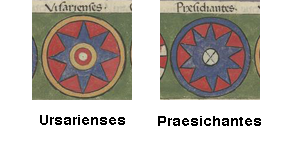
This page created 23 March 2014, and last modified: 13 December 2015 (Jones commentary added)

The 21st of the 32 units of legiones comitatenses listed (98/9.118 in Ingo Maier's numbering scheme) in the Magister Peditum's infantry roster is called the Ursarienses; it is assigned (102/5.137) to the Magister Equitum's Gallic command. Its shield pattern (96#11) as shown in various manuscripts, under the matching label (96.l) Ursarienses, is as below:

The pattern shows a red field with a yellow rim; the boss centre is white, then red (yellow in M), and edged with yellow (white in B). Projecting from the boss to the edge of the yellow rim is an indigo purple 8-pointed star (faded to maroon in M, W, and 16-pointed in the Froben edition, B, where it is also coloured purple instead).
It is likely this unit is the same as (formerly) commanded by the Praefectus militum Ursariensium (151.9) at Rotomago (i.e. Rotomagus, modern Rouen in Normandy) under the Dux tractus Armoricani et Nervicani; see under his entry for more details. A gravestone from Amiens (CIL 13.3492) belonging to an IMAG[i]N(ifer) N(umeri) URSARIEN(sium) surely refers to this unit, Amiens being just 100 kilometres from Rouen as the crow flies.
The pattern is somewhat similar to the previous unit in the Magister Peditum's list, the Praesidienses (98/9.117; mis-spelled Praesichantes in most text versions), as can be seen by comparing their patterns, using the appropriate Parisian manuscript pictures, as shown below:

Note that the Praesidienses is the next unit listed after the Ursarienses in the Gallic list, swapping the order seen in the Magister Peditum's infantry roster. The similarity of their shield patterns, together with their interchangeable list positions, would indicate they were likely a brigaded pair of units.
The name Ursarienses means "the bears", and would seem to derive from Legio III Italica. This legion was raised by Aurelius in the 2nd century, and going by coinage, had the stork as its symbol; its main base was Castra Regina (modern Regensburg in Germany), although detachments are known to have served in many other places. In the Notitia, one detachment is assigned to the command of the Comes Illyricum using the name Tertiani (102/5.104), while the rest of Legio III Italica is under the overall command of the Dux Raetiae primae et secundae, and is split between a number of prefects stationed in various places in Raetia I & II:
147.5 Praefectus legionis tertiae Italicae parti superioris, at Castra Regina (i.e. modern Regensburg), near Vallato:It is the positioning of the Milites Ursarienses in this list that makes it highly likely it is also a detachment of legionaries from Legio III Italica. The Raetian detachments of Legio III Italica are unusual in that they are not all located along the riverine border; some are rather far to the south, guarding the trans-Alpine routes to Italy. The soldiers of the Ursarienses appear to picked up a new local animal totem to replace the stork; even today, Urs is a stereotypically Swiss male name, and the animal features frequently on Swiss coats of arms and flags.
147.6 Praefectus legionis tertiae Italicae parti superioris deputatae ripae primae, at Submuntorio (i.e. Summuntorium, modern Burghoefen Mertingen, Bavaria);
147.7 Praefectus legionis tertiae Italicae proparte media praetendentis, from Vimania Cassiliacum to Cambidano (i.e. from modern Isny-Bettmauer to Kempten, Bavaria);
147.8 Praefectus militum Ursariensium, at Guntiae (i.e Guntia, modern Guenzburg, Bavria);
147.9 Praefectus legionis tertiae Italicae transvectioni specierum deputatae, at Foetibus (i.e. Foetes, modern Fuessen, Bavaria); and
147.10 Praefectus legionis tertiae Italicae transvectioni specierum deputatae, at Teriolis (i.e. modern Zirl, Tyrol, Austria).
Note that Jones considered 147.8, the Milites Ursarienses, to be the same as 98/9.118, the comitatenses Ursarienses. While this is possible, it is less likely in my opinion, as an Armorican unit would have been less likely to have been destroyed in the turmoil of the first two decades of the 5th century than a German unit (he considered the Armorican unit to be the same as the Cursarienses iuniores (102/5.156) of the Magister Equitum's Gallic command).
1. Maier, Ingo; "Appendix 4: Numeration of the new edition of the compilation 'notitia dignitatum' (Cnd)"; last accessed 7 December 2015. See also for here for numbering examples. Return
2. Jones, A.H.M.; "The Later Roman Empire, 284-602; A Social, Economic, and Administrative Survey"; Blackwell, Oxford, 1964 (3 volumes); at p 365-6 of vol. 3. Return

Return to the Notitia alphabetical unit list page.
Return to my Notitia index page.